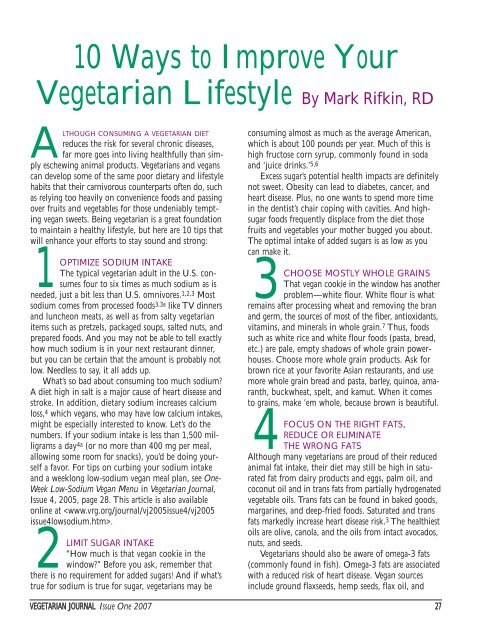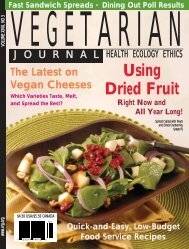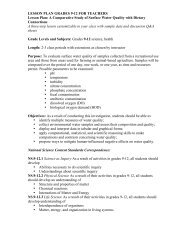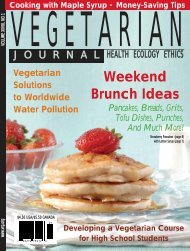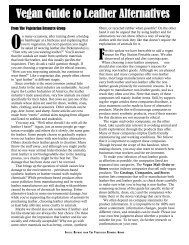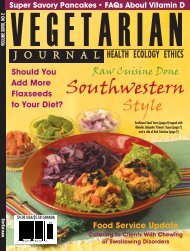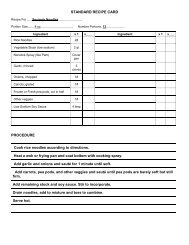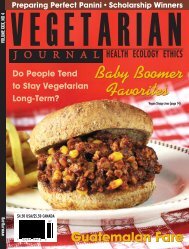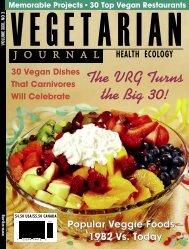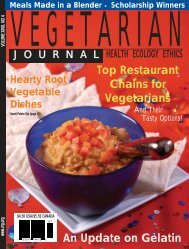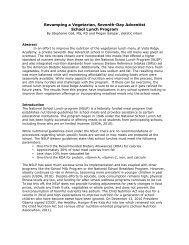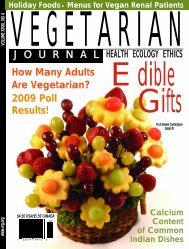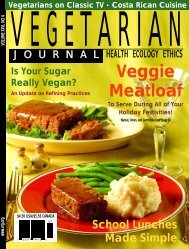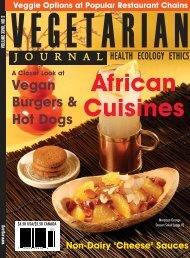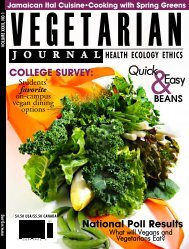Vegan Thickeners - The Vegetarian Resource Group
Vegan Thickeners - The Vegetarian Resource Group
Vegan Thickeners - The Vegetarian Resource Group
You also want an ePaper? Increase the reach of your titles
YUMPU automatically turns print PDFs into web optimized ePapers that Google loves.
10 Ways to Improve Your<br />
<strong>Vegetarian</strong> Lifestyle By Mark Rifkin, RD<br />
ALTHOUGH CONSUMING A VEGETARIAN DIET<br />
reduces the risk for several chronic diseases,<br />
far more goes into living healthfully than simply<br />
eschewing animal products. <strong>Vegetarian</strong>s and vegans<br />
can develop some of the same poor dietary and lifestyle<br />
habits that their carnivorous counterparts often do, such<br />
as relying too heavily on convenience foods and passing<br />
over fruits and vegetables for those undeniably tempting<br />
vegan sweets. Being vegetarian is a great foundation<br />
to maintain a healthy lifestyle, but here are 10 tips that<br />
will enhance your efforts to stay sound and strong:<br />
1OPTIMIZE SODIUM INTAKE<br />
<strong>The</strong> typical vegetarian adult in the U.S. consumes<br />
four to six times as much sodium as is<br />
needed, just a bit less than U.S. omnivores. 1,2,3 Most<br />
sodium comes from processed foods 3,3a like TV dinners<br />
and luncheon meats, as well as from salty vegetarian<br />
items such as pretzels, packaged soups, salted nuts, and<br />
prepared foods. And you may not be able to tell exactly<br />
how much sodium is in your next restaurant dinner,<br />
but you can be certain that the amount is probably not<br />
low. Needless to say, it all adds up.<br />
What’s so bad about consuming too much sodium?<br />
A diet high in salt is a major cause of heart disease and<br />
stroke. In addition, dietary sodium increases calcium<br />
loss, 4 which vegans, who may have low calcium intakes,<br />
might be especially interested to know. Let’s do the<br />
numbers. If your sodium intake is less than 1,500 milligrams<br />
a day 4a (or no more than 400 mg per meal,<br />
allowing some room for snacks), you’d be doing yourself<br />
a favor. For tips on curbing your sodium intake<br />
and a weeklong low-sodium vegan meal plan, see One-<br />
Week Low-Sodium <strong>Vegan</strong> Menu in <strong>Vegetarian</strong> Journal,<br />
Issue 4, 2005, page 28. This article is also available<br />
online at .<br />
2LIMIT SUGAR INTAKE<br />
“How much is that vegan cookie in the<br />
window?” Before you ask, remember that<br />
there is no requirement for added sugars! And if what’s<br />
true for sodium is true for sugar, vegetarians may be<br />
consuming almost as much as the average American,<br />
which is about 100 pounds per year. Much of this is<br />
high fructose corn syrup, commonly found in soda<br />
and ‘juice drinks.’ 5,6<br />
Excess sugar’s potential health impacts are definitely<br />
not sweet. Obesity can lead to diabetes, cancer, and<br />
heart disease. Plus, no one wants to spend more time<br />
in the dentist’s chair coping with cavities. And highsugar<br />
foods frequently displace from the diet those<br />
fruits and vegetables your mother bugged you about.<br />
<strong>The</strong> optimal intake of added sugars is as low as you<br />
can make it.<br />
3CHOOSE MOSTLY WHOLE GRAINS<br />
That vegan cookie in the window has another<br />
problem—white flour. White flour is what<br />
remains after processing wheat and removing the bran<br />
and germ, the sources of most of the fiber, antioxidants,<br />
vitamins, and minerals in whole grain. 7 Thus, foods<br />
such as white rice and white flour foods (pasta, bread,<br />
etc.) are pale, empty shadows of whole grain powerhouses.<br />
Choose more whole grain products. Ask for<br />
brown rice at your favorite Asian restaurants, and use<br />
more whole grain bread and pasta, barley, quinoa, amaranth,<br />
buckwheat, spelt, and kamut. When it comes<br />
to grains, make ’em whole, because brown is beautiful.<br />
4FOCUS ON THE RIGHT FATS,<br />
REDUCE OR ELIMINATE<br />
THE WRONG FATS<br />
Although many vegetarians are proud of their reduced<br />
animal fat intake, their diet may still be high in saturated<br />
fat from dairy products and eggs, palm oil, and<br />
coconut oil and in trans fats from partially hydrogenated<br />
vegetable oils. Trans fats can be found in baked goods,<br />
margarines, and deep-fried foods. Saturated and trans<br />
fats markedly increase heart disease risk. 3 <strong>The</strong> healthiest<br />
oils are olive, canola, and the oils from intact avocados,<br />
nuts, and seeds.<br />
<strong>Vegetarian</strong>s should also be aware of omega-3 fats<br />
(commonly found in fish). Omega-3 fats are associated<br />
with a reduced risk of heart disease. <strong>Vegan</strong> sources<br />
include ground flaxseeds, hemp seeds, flax oil, and<br />
VEGETARIAN JOURNAL Issue One 2007 27


